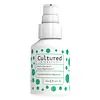What's inside
What's inside
 Key Ingredients
Key Ingredients

 Benefits
Benefits

 Concerns
Concerns

 Ingredients Side-by-side
Ingredients Side-by-side

Water
Skin ConditioningDimethicone
EmollientDiglycerin
HumectantCamellia Sinensis Leaf
PerfumingGlycerin
HumectantDiphenylsiloxy Phenyl Trimethicone
Skin ConditioningNeopentyl Glycol Diethylhexanoate
EmollientButylene Glycol
HumectantDiisostearyl Malate
EmollientPEG-10 Dimethicone
Skin ConditioningPropanediol
SolventDisteardimonium Hectorite
StabilisingOphiopogon Japonicus Root Extract
Skin ConditioningIndigofera Tinctoria Leaf Extract
Skin ConditioningCeramide Ng
Skin ConditioningPalmitic Acid
EmollientLinoleic Acid
CleansingSodium Hyaluronate
HumectantPolygonum Tinctorium Leaf/Stem Extract
Skin ConditioningCetyl Alcohol
EmollientSucrose Stearate
EmollientSucrose Palmitate
EmollientMaltodextrin
AbsorbentSargassum Vulgare Extract
Skin ConditioningSaccharomyces Ferment Filtrate
HumectantHydrolyzed Lagenaria Siceraria Fruit Juice
Skin ConditioningSalvia Miltiorrhiza Root Extract
Skin ConditioningTocopherol
AntioxidantLauryl PEG-9 Polydimethylsiloxyethyl Dimethicone
Skin ConditioningMagnesium Sulfate
Hydrogenated Lecithin
EmulsifyingPhytosterols
Skin ConditioningEthylhexylglycerin
Skin ConditioningPhenoxyethanol
PreservativeMica
Cosmetic ColorantCI 77891
Cosmetic ColorantWater, Dimethicone, Diglycerin, Camellia Sinensis Leaf, Glycerin, Diphenylsiloxy Phenyl Trimethicone, Neopentyl Glycol Diethylhexanoate, Butylene Glycol, Diisostearyl Malate, PEG-10 Dimethicone, Propanediol, Disteardimonium Hectorite, Ophiopogon Japonicus Root Extract, Indigofera Tinctoria Leaf Extract, Ceramide Ng, Palmitic Acid, Linoleic Acid, Sodium Hyaluronate, Polygonum Tinctorium Leaf/Stem Extract, Cetyl Alcohol, Sucrose Stearate, Sucrose Palmitate, Maltodextrin, Sargassum Vulgare Extract, Saccharomyces Ferment Filtrate, Hydrolyzed Lagenaria Siceraria Fruit Juice, Salvia Miltiorrhiza Root Extract, Tocopherol, Lauryl PEG-9 Polydimethylsiloxyethyl Dimethicone, Magnesium Sulfate, Hydrogenated Lecithin, Phytosterols, Ethylhexylglycerin, Phenoxyethanol, Mica, CI 77891
Water
Skin ConditioningGlycerin
HumectantCoco-Caprylate/Caprate
EmollientBorago Officinalis Seed Oil
EmollientLactococcus Ferment Lysate
Skin ConditioningInulin
Skin ConditioningSqualane
EmollientCetyl Phosphate
EmulsifyingSaccharomyces/Xylinum/Black Tea Ferment
Skin ConditioningSodium Hyaluronate
HumectantChlorella Vulgaris Extract
Skin ConditioningLactobacillus Ferment
Skin ConditioningPropanediol
SolventArginine
MaskingSodium Stearoyl Glutamate
CleansingMaltodextrin
AbsorbentXanthan Gum
EmulsifyingCetyl Alcohol
EmollientAnthemis Nobilis Flower Oil
MaskingSodium Chloride
MaskingLactic Acid
BufferingCitric Acid
BufferingHydroxyacetophenone
AntioxidantSodium Levulinate
Skin ConditioningSodium Anisate
AntimicrobialPotassium Sorbate
PreservativeSodium Benzoate
MaskingWater, Glycerin, Coco-Caprylate/Caprate, Borago Officinalis Seed Oil, Lactococcus Ferment Lysate, Inulin, Squalane, Cetyl Phosphate, Saccharomyces/Xylinum/Black Tea Ferment, Sodium Hyaluronate, Chlorella Vulgaris Extract, Lactobacillus Ferment, Propanediol, Arginine, Sodium Stearoyl Glutamate, Maltodextrin, Xanthan Gum, Cetyl Alcohol, Anthemis Nobilis Flower Oil, Sodium Chloride, Lactic Acid, Citric Acid, Hydroxyacetophenone, Sodium Levulinate, Sodium Anisate, Potassium Sorbate, Sodium Benzoate
 Reviews
Reviews

Ingredients Explained
These ingredients are found in both products.
Ingredients higher up in an ingredient list are typically present in a larger amount.
Cetyl Alcohol is a fatty alcohol. Fatty Alcohols are most often used as an emollient or to thicken a product.
Its main roles are:
Though it has "alcohol" in the name, it is not related to denatured alcohol or ethyl alcohol.
The FDA allows products labeled "alcohol-free" to have fatty alcohols.
Learn more about Cetyl AlcoholGlycerin is already naturally found in your skin. It helps moisturize and protect your skin.
A study from 2016 found glycerin to be more effective as a humectant than AHAs and hyaluronic acid.
As a humectant, it helps the skin stay hydrated by pulling moisture to your skin. The low molecular weight of glycerin allows it to pull moisture into the deeper layers of your skin.
Hydrated skin improves your skin barrier; Your skin barrier helps protect against irritants and bacteria.
Glycerin has also been found to have antimicrobial and antiviral properties. Due to these properties, glycerin is often used in wound and burn treatments.
In cosmetics, glycerin is usually derived from plants such as soybean or palm. However, it can also be sourced from animals, such as tallow or animal fat.
This ingredient is organic, colorless, odorless, and non-toxic.
Glycerin is the name for this ingredient in American English. British English uses Glycerol/Glycerine.
Learn more about GlycerinMaltodextrin is a polysaccharide. It is derived from starch such as rice, corn, wheat, or potato starch.
In food, Maltodextrin is used to improve the texture and thicken a product. Due to its structure, it can help create a gel texture. As an emulsion stabilizer, it helps keep the ingredients in a product together.
As a polysaccharide, Maltodextrin has moisturizing properties. Polysaccharides are a type of carbohydrate. The top layer of skin uses polysaccharides to retain water, keeping the skin hydrated.
Maltodextrin is water soluble and has a sweet taste.
Learn more about MaltodextrinPropanediol is an all-star ingredient. It softens, hydrates, and smooths the skin.
It’s often used to:
Propanediol is not likely to cause sensitivity and considered safe to use. It is derived from corn or petroleum with a clear color and no scent.
Learn more about PropanediolSodium Hyaluronate is hyaluronic acid's salt form. It is commonly derived from the sodium salt of hyaluronic acid.
Like hyaluronic acid, it is great at holding water and acts as a humectant. This makes it a great skin hydrating ingredient.
Sodium Hyaluronate is naturally occurring in our bodies and is mostly found in eye fluid and joints.
These are some other common types of Hyaluronic Acid:
Learn more about Sodium HyaluronateWater. It's the most common cosmetic ingredient of all. You'll usually see it at the top of ingredient lists, meaning that it makes up the largest part of the product.
So why is it so popular? Water most often acts as a solvent - this means that it helps dissolve other ingredients into the formulation.
You'll also recognize water as that liquid we all need to stay alive. If you see this, drink a glass of water. Stay hydrated!
Learn more about Water